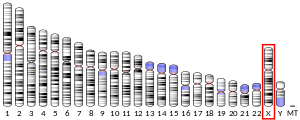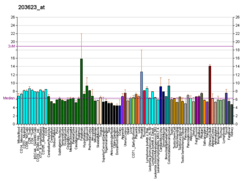PLXNA3
Plexin-A3 is a protein that in humans is encoded by the PLXNA3 gene.[5][6][7]
References
- GRCh38: Ensembl release 89: ENSG00000130827 - Ensembl, May 2017
- GRCm38: Ensembl release 89: ENSMUSG00000031398 - Ensembl, May 2017
- "Human PubMed Reference:". National Center for Biotechnology Information, U.S. National Library of Medicine.
- "Mouse PubMed Reference:". National Center for Biotechnology Information, U.S. National Library of Medicine.
- Bione S, Tamanini F, Maestrini E, Tribioli C, Poustka A, Torri G, Rivella S, Toniolo D (Jan 1994). "Transcriptional organization of a 450-kb region of the human X chromosome in Xq28". Proc Natl Acad Sci U S A. 90 (23): 10977–81. doi:10.1073/pnas.90.23.10977. PMC 47904. PMID 8248200.
- Chen EY, Zollo M, Mazzarella R, Ciccodicola A, Chen CN, Zuo L, Heiner C, Burough F, Repetto M, Schlessinger D, D'Urso M (Jun 1997). "Long-range sequence analysis in Xq28: thirteen known and six candidate genes in 219.4 kb of high GC DNA between the RCP/GCP and G6PD loci". Hum Mol Genet. 5 (5): 659–68. doi:10.1093/hmg/5.5.659. PMID 8733135.
- "Entrez Gene: PLXNA3 plexin A3".
Further reading
- Sedlacek Z, Korn B, Konecki DS, Siebenhaar R, Coy JF, Kioschis P, Poustka A (1994). "Construction of a transcription map of a 300 kb region around the human G6PD locus by direct cDNA selection". Hum. Mol. Genet. 2 (11): 1865–9. doi:10.1093/hmg/2.11.1865. PMID 8281148.
- Maestrini E, Tamagnone L, Longati P, Cremona O, Gulisano M, Bione S, Tamanini F, Neel BG, Toniolo D, Comoglio PM (1996). "A family of transmembrane proteins with homology to the MET-hepatocyte growth factor receptor". Proc. Natl. Acad. Sci. U.S.A. 93 (2): 674–8. doi:10.1073/pnas.93.2.674. PMC 40111. PMID 8570614.
- Kameyama T, Murakami Y, Suto F, Kawakami A, Takagi S, Hirata T, Fujisawa H (1996). "Identification of plexin family molecules in mice". Biochem. Biophys. Res. Commun. 226 (2): 396–402. doi:10.1006/bbrc.1996.1367. PMID 8806646.
- Tamagnone L, Artigiani S, Chen H, He Z, Ming GI, Song H, Chedotal A, Winberg ML, Goodman CS, Poo M, Tessier-Lavigne M, Comoglio PM (1999). "Plexins are a large family of receptors for transmembrane, secreted, and GPI-anchored semaphorins in vertebrates". Cell. 99 (1): 71–80. doi:10.1016/S0092-8674(00)80063-X. PMID 10520995.
- Dias Neto E, Correa RG, Verjovski-Almeida S, Briones MR, Nagai MA, da Silva W, Zago MA, Bordin S, Costa FF, Goldman GH, Carvalho AF, Matsukuma A, Baia GS, Simpson DH, Brunstein A, de Oliveira PS, Bucher P, Jongeneel CV, O'Hare MJ, Soares F, Brentani RR, Reis LF, de Souza SJ, Simpson AJ (2000). "Shotgun sequencing of the human transcriptome with ORF expressed sequence tags". Proc. Natl. Acad. Sci. U.S.A. 97 (7): 3491–6. doi:10.1073/pnas.97.7.3491. PMC 16267. PMID 10737800.
- Brandenberger R, Wei H, Zhang S, Lei S, Murage J, Fisk GJ, Li Y, Xu C, Fang R, Guegler K, Rao MS, Mandalam R, Lebkowski J, Stanton LW (2005). "Transcriptome characterization elucidates signaling networks that control human ES cell growth and differentiation". Nat. Biotechnol. 22 (6): 707–16. doi:10.1038/nbt971. PMID 15146197.
- Fu GK, Wang JT, Yang J, Au-Young J, Stuve LL (2005). "Circular rapid amplification of cDNA ends for high-throughput extension cloning of partial genes". Genomics. 84 (1): 205–10. doi:10.1016/j.ygeno.2004.01.011. PMID 15203218.
This article is issued from Wikipedia. The text is licensed under Creative Commons - Attribution - Sharealike. Additional terms may apply for the media files.




